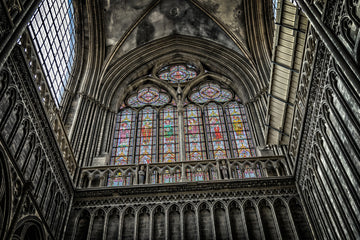The Great Cathedrals of the Middle Ages: Collective Masterpieces Without Modern Technology
The Middle Ages saw the creation of some of the most impressive buildings in history - the great Gothic cathedrals. Unlike pyramids and temples, which were often built to honor a single ruler, these cathedrals were not commissioned by kings or pharaohs.
Instead, they were projects built by ordinary people, working not out of compulsion or for money, but out of spiritual conviction.
A key aspect that made the construction of these huge, detailed structures possible was the use of newly discovered Roman building techniques. Elements such as pulleys, pointed arches and flying buttresses made it possible to make the cathedrals taller and more light-filled.
These technical innovations made it possible to build “walls of light” in which large window areas were held together by filigree stone structures.
In addition to technology, time also played a major role. While pyramids often had to be completed within the lifetime of a pharaoh, cathedral builders had the luxury of patience. Some buildings, such as Chartres Cathedral, were completed in just 26 years, while others, such as Cologne Cathedral, took centuries to complete.
But the vision remained, even though generations of workers did not live to see their projects completed.
It wasn't just time and technology that made these buildings possible - it was the collective will to create something greater. Each city wanted to outdo the others with its cathedral, which led to friendly competition. Beauvais Cathedral, for example, surpassed Amiens Cathedral by building the tallest church in Europe.
The cathedrals of the Middle Ages remain living monuments of a united culture and tradition to this day. They show what a community can achieve when it agrees on common values.
At a time when our shared cultural heritage often seems threatened, the question remains: How can we remain true to this vision and invest in a future that we ourselves may never experience?
Forma Aeternus , the concept of "eternal form", reflects this idea. It represents buildings and works of art that endure across generations and connect communities across space and time.







